Resellos on sábanas - Michoacán and Colima
Morelia was captured in July 1914 and Gertrudis G. Sánchez named Provisional Governor. The sábanas were made forced circulation by a decree of 26 November 1914Periódico Oficial, 29 November 1914. Sánchez went to meet Villa at Irapuato in the last days of November 1914. The meeting was very cordial, and Villa gave Sánchez arms, ammunition and a considerable sum of dos caritas. Then the next day Villa summoned Sánchez to Celaya and ordered him shot: Sanchéz persuaded Villa to suspend the order, whereupon he returned to Morelia and promptly declared himself a ConventionistSánchez allowed General Murgia’s Constitutionalist troops to pass through his domain on their way to reinforce General Diéguez at Guadalajara, Jalisco. Sánchez’ treachery cost him his life: Villa had him executed early in 1915.
Morelia – Jefatura de Hacienda
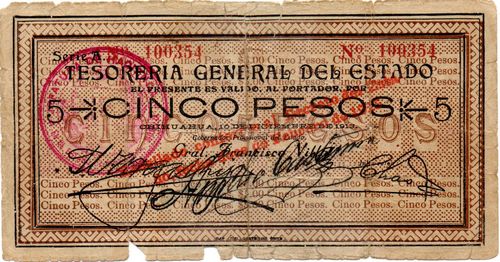
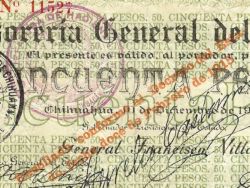 A large (42mm) round purple seal with ‘JEFATURA DE HACIENDA - EN EL ESTADO DE MICHOACAN - MORELIA’ and orange two-line text ‘Resellado conforme al Decreto del Esta-/do fecha doce de febrero de 1915’.
A large (42mm) round purple seal with ‘JEFATURA DE HACIENDA - EN EL ESTADO DE MICHOACAN - MORELIA’ and orange two-line text ‘Resellado conforme al Decreto del Esta-/do fecha doce de febrero de 1915’.
By February 1915 because of the number of forgeries in Morelia the sábanas had been driven from circulation. A careful revision was needed to protect holders so on 12 February Sánchez set a period of fifteen days for sábanas (and Monclova issues) to be checked and restamped in the Jefatura de Hacienda in Morelia in the manner prescribed by the central government. People outside the state capital were instructed to hand their notes in at the Administradores y Agentes Subalternos del Timbre for forwarding to the capital. After this time limit only the notes with the resello would be of forced circulationPeriódico Oficial, 18 February 1915. On 8 February the Tesorería Municipal had reported to the Presidente Municipal that the sábanas had in fact ceased to circulate, but that there was still $1,353.50 in such notes in the Tesorería. The letter was copied to the Prefecto del Distrito to pass on to the Supremo Gobierno for instructions (AMICH, caja 29, exp. 61). The timespan is too short to suggest that the 12 February decree was the result of this particular request.
Michoacán – Pagaduría General
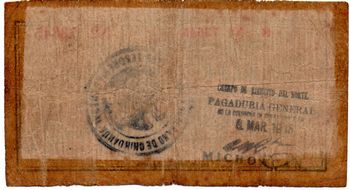
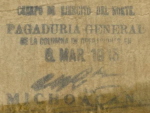 ‘CUERPO DE EJERCITO DEL NORTE – PAGADURÍA GENERAL – DE LA COLUMNA DE OPERACIONES EN –MICHOACAN, signature and date 8 MAR 1915(?)’
‘CUERPO DE EJERCITO DEL NORTE – PAGADURÍA GENERAL – DE LA COLUMNA DE OPERACIONES EN –MICHOACAN, signature and date 8 MAR 1915(?)’
José I. Prieto was named Governor and Jefe de Operaciones when the Villistas recaptured Morelia during the last days of February 1915. A decree of 4 March listed the sábanas amongst the notes of forced circulation without making any reference to resellos, whilst three days later another decreed[text needed] that some local issues should be restampedPeriódico Oficial, 7 March 1915.
A notice on 10 March said that holders of the Monclova and Gobierno Provisional issues should take them to the office of the Pagaduría General de la Jefatura de Operaciones for revalidation by means of a resello on the reverse of each note. In the other administrative centres the notes were to be taken to the tax officesPeriódico Oficial, 14 March 1915. This arrangement was altered on 18 March as holders were to take them to the Pagaduría General de la Jefatura de Operaciones, Jefatura de Hacienda and Administración del Timbre to exchange them for notes of the state of ChihuahuaPeriódico Oficial, 21 March 1915. Presumably the Pagaduría General overstamped the notes before they issued them.
The catalogues list a resello ‘Revalidado decreto de 17 de Diciembre de 1914. Pagaduria General de la Columna de Operaciones Michoacan’ but this was probably this resello on a REVALIDADO note.
Colima – Administración Principal de Timbre
‘Administracion Principal de Timbre, Colima’.
Colima is the capital of the state of the same name, about 200 kilometres south of Guadalajara.
This was a very short-lived resello. On 12 December 1914 the Governor, Miguel Orozco, issued a circular that people had until 25 December to present their sábanas in the Administración Principal del Timbre for revalidation. The offices would be open from 10.00 till 12.00 in the morning and 3.00 to 4.00 in the afternoonPeriódico Oficial, 19 December 1914. However, Carranza had already issued his decree nullifying the Chihuahua issues on 27 November and this was transmitted to the Interim Governor Esteban B. Calderón, via Zapotlán, and published in the Periódico Oficial of 28 DecemberPeriódico Oficial, 28 December 1914. Presumably the news will have been common knowledge before then, so there was a maximum of a few days, for three hours a day, when this resello could have been applied. However, on 26 December, J. J. Valadés, the interim Administrador Principal, wrote to the governor that up to the previous day his office had revalidated $25,695 in Villista notesAHEC, leg. 864, 1914.
Manzanillo – Administración Subalterna de Timbre
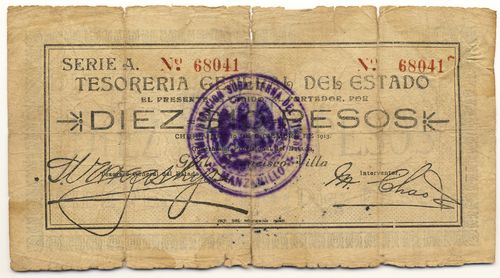
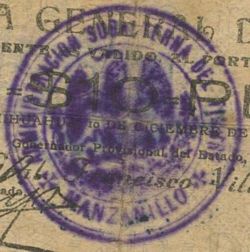 A round (42mm) purple seal with ‘ADMINISTRACION SUBALTERNA DEL TIMBRE – MANZANILLO’.
A round (42mm) purple seal with ‘ADMINISTRACION SUBALTERNA DEL TIMBRE – MANZANILLO’.
Manzanillo is the main port of Colima, a small state south of Jalisco.
This was probably used in December 1914, at the same time as the Colima resello above.
